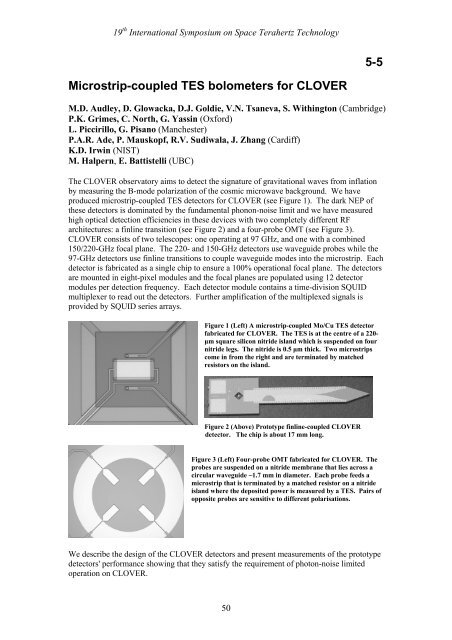Program and Abstract Book - SRON
Program and Abstract Book - SRON
Program and Abstract Book - SRON
You also want an ePaper? Increase the reach of your titles
YUMPU automatically turns print PDFs into web optimized ePapers that Google loves.
19 th International Symposium on Space Terahertz Technology<br />
5-5<br />
Microstrip-coupled TES bolometers for CLOVER<br />
M.D. Audley, D. Glowacka, D.J. Goldie, V.N. Tsaneva, S. Withington (Cambridge)<br />
P.K. Grimes, C. North, G. Yassin (Oxford)<br />
L. Piccirillo, G. Pisano (Manchester)<br />
P.A.R. Ade, P. Mauskopf, R.V. Sudiwala, J. Zhang (Cardiff)<br />
K.D. Irwin (NIST)<br />
M. Halpern, E. Battistelli (UBC)<br />
The CLOVER observatory aims to detect the signature of gravitational waves from inflation<br />
by measuring the B-mode polarization of the cosmic microwave background. We have<br />
produced microstrip-coupled TES detectors for CLOVER (see Figure 1). The dark NEP of<br />
these detectors is dominated by the fundamental phonon-noise limit <strong>and</strong> we have measured<br />
high optical detection efficiencies in these devices with two completely different RF<br />
architectures: a finline transition (see Figure 2) <strong>and</strong> a four-probe OMT (see Figure 3).<br />
CLOVER consists of two telescopes: one operating at 97 GHz, <strong>and</strong> one with a combined<br />
150/220-GHz focal plane. The 220- <strong>and</strong> 150-GHz detectors use waveguide probes while the<br />
97-GHz detectors use finline transitions to couple waveguide modes into the microstrip. Each<br />
detector is fabricated as a single chip to ensure a 100% operational focal plane. The detectors<br />
are mounted in eight-pixel modules <strong>and</strong> the focal planes are populated using 12 detector<br />
modules per detection frequency. Each detector module contains a time-division SQUID<br />
multiplexer to read out the detectors. Further amplification of the multiplexed signals is<br />
provided by SQUID series arrays.<br />
Figure 1 (Left) A microstrip-coupled Mo/Cu TES detector<br />
fabricated for CLOVER. The TES is at the centre of a 220-<br />
μm square silicon nitride isl<strong>and</strong> which is suspended on four<br />
nitride legs. The nitride is 0.5 μm thick. Two microstrips<br />
come in from the right <strong>and</strong> are terminated by matched<br />
resistors on the isl<strong>and</strong>.<br />
Figure 2 (Above) Prototype finline-coupled CLOVER<br />
detector. The chip is about 17 mm long.<br />
Figure 3 (Left) Four-probe OMT fabricated for CLOVER. The<br />
probes are suspended on a nitride membrane that lies across a<br />
circular waveguide ~1.7 mm in diameter. Each probe feeds a<br />
microstrip that is terminated by a matched resistor on a nitride<br />
isl<strong>and</strong> where the deposited power is measured by a TES. Pairs of<br />
opposite probes are sensitive to different polarisations.<br />
We describe the design of the CLOVER detectors <strong>and</strong> present measurements of the prototype<br />
detectors' performance showing that they satisfy the requirement of photon-noise limited<br />
operation on CLOVER.<br />
50
















